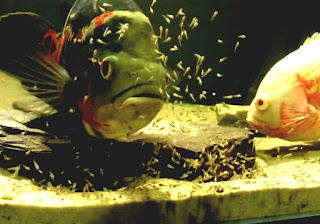The oscar (Astronotus ocellatus) is a species of fish from the cichlid family known under a variety of common names, including tiger oscar, velvet cichlid, and marble cichlid. In tropical South America, where the species naturally resides, A. ocellatus specimens are often found for sale as a food fish in the local markets. The fish has been introduced to other areas, including China, Australia, and the United States. It is considered a popular aquarium fish in Europe and the U.S.
Taxonomy
LIOW VIDEO -- TIGER OSCAR FISH EATING FROGS 猪鱼åƒé'è›™ - In this video,I'm feeding my 3yrs 6months tiger oscar fish with small bull frogs.If I give my Oscar superworms,I need to give 5 to 6 each time(i.e:killed 5 to 6 life).To reduce the killing...
The species was originally described by Louis Agassiz in 1831 as Lobotes ocellatus, as he mistakenly believed the species was marine; later work assigned the species to the genus Astronotus. The species also has a number of junior synonyms: Acara compressus, Acara hyposticta, Astronotus ocellatus zebra, and Astronotus orbiculatus.
Description
A. ocellatus examples have been reported to grow to about 45Â cm (18Â in) in length and 1.6 kilograms (3.5Â lb) in weight. The wild-caught forms of the species are typically darkly coloured with yellow-ringed spots or ocelli on the caudal peduncle and on the dorsal fin. These ocelli have been suggested to function to limit fin-nipping by piranha (Serrasalmus spp.), which co-occur with A. ocellatus in its natural environment. The species is also able to rapidly alter its colouration, a trait which facilitates ritualised territorial and combat behaviours amongst conspecifics. Juvenile oscars have a different colouration from adults, and are striped with white and orange wavy bands and have spotted heads.
Distribution and habitat
A. ocellatus is native to Peru, Ecuador, Colombia, Brazil, and French Guiana, and occurs in the Amazon River basin, along the Amazon, Içá, Negro, Solimões, and Ucayali River systems, and also in the Approuague and Oyapock River drainages. In its natural environment, the species typically occurs in slow-moving white-water habitats, and has been observed sheltering under submerged branches. Feral populations also occur in China, northern Australia, and Florida, USA as a byproduct of the ornamental fish trade. The species is limited in its distribution by its intolerance of cooler water temperatures, the lower lethal limit for the species is 12.9 °C (55.22 °F).
Reproduction
Although the species is widely regarded as sexually monomorphic, males have been suggested to grow more quickly, and in some naturally occurring strains, males are noted to possess dark blotches on the base of their dorsal fins. The species reaches sexual maturity around one year of age, and continues to reproduce for 9â€"10 years. Frequency and timing of spawning may be related to the occurrence of rain. A. ocellatus fish are biparental substrate spawners, though detailed information regarding their reproduction in the wild is scarce.
In captivity, pairs are known to select and clean generally flattened horizontal or vertical surfaces on which to lay their 1,000 to 3,000 eggs. Like most cichlids, A. ocellatus practices brood care, although the duration of brood care in the wild remains unknown.
In the aquarium
The oscar is one of the most popular cichlids in the aquarium hobby.
Feeding
Captive oscars may be fed prepared fish food designed for large carnivorous fish: crayfish, worms, and insects (such as flies, crickets and grasshoppers). Feeding live foods may increase the rate of growth but also may cause endoparasites. Poultry and/or mammalian flesh, including beefheart, should not be fed long term as these fatty foods will contribute to fatty liver disease. Since these fish eat fruit in the wild, items such as melons, oranges, and other fruits can also be used as a type of food. Live feeder fish can be given, but fish such as goldfish and minnows should not be fed. These contain an enzyme (thiaminase) within their flesh which binds vitamin B1, leading to deficiency. Most fish eaten by A. ocellatus in the wild are relatively sedentary catfish, including Bunocephalus, Rineloricaria, and Ochmacanthus species. The species uses a suction mechanism to capture prey, and has been reported to exhibit "laying-on-side" death mimicry in a similar fashion to Parachromis friedrichsthalii and Nimbochromis livingstonii. The species also has an absolute requirement for vitamin C, and develops health problems in its absence.
Territorial behavior
Oscars will often lay claim to an area of the aquarium and will be very aggressive towards other fish encroaching on their newly established territory inside the aquarium or lake. The size of the territory varies depending on the size and aggressiveness of the fish based on its surroundings. Once the oscar establishes a territory, it will vigorously defend it by chasing away other fish.
Varieties
A number of ornamental varieties of A. ocellatus have been developed for the aquarium industry. These include forms with greater intensity and quantities of red marbling across the body, albino, leucistic, and xanthistic forms. A. ocellatus with marbled patches of red pigmentation are sold as red tiger oscars, while those strains with mainly red colouration of the flanks are frequently sold under the trade name of red oscars. The patterning of red pigment differs between individuals; in the United Kingdom, one A. ocellatus reportedly had markings that resembled the Arabic word for "Allah". In recent years long-finned varieties have also been developed. The species is also occasionally artificially coloured by a process known as painting.

No comments:
Post a Comment